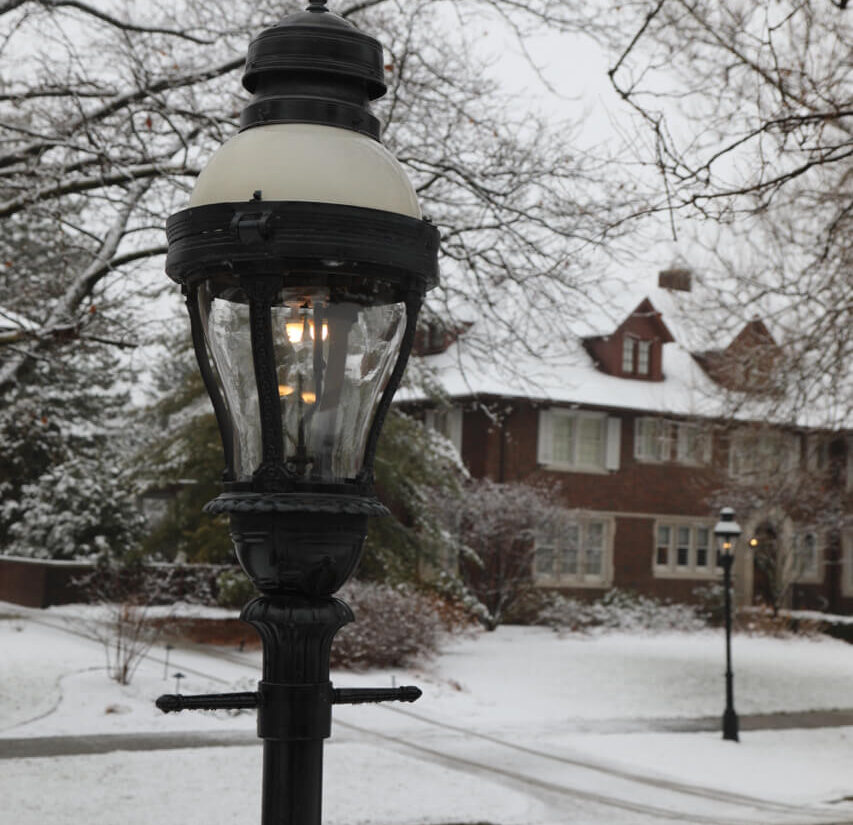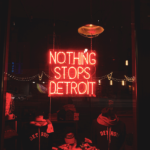Historic Gas Lamps

Indian Village’s iconic gaslights were first installed in 1968 by a determined group of neighbors who wanted to bring added beauty and security to the neighborhood. In the past 50 plus years, those gaslights have survived rock-throwing vandals, threats by the city to tear them out, and even a nationwide ban passed by Congress.
The idea of installing gas lighting throughout the Village had been discussed as early as the 1950s, but it wasn’t until 1968 that the Indian Village Association organized a project to take action.
It was just months after Detroit’s deadly and destructive riots that came alarmingly close to their doorsteps, and Villagers were concerned about security, especially after dark. The neighborhood was also dealing with the devastating Dutch Elm disease that was quickly claiming the 70 year old towering Elm trees planted just as the first homes were built in 1895.
The project was seen as a way to brighten Indian Village’s chances for convincing Detroit’s Common Council to declare the neighborhood an historic district, the first step towards gaining the national historic designation that would come later in 1972.
So the IVA struck a deal with the Michigan Consolidated Gas Company to offer the Victorian-style “Newport 1000” to residents on a voluntary basis at a cost of $175 per lamp, about $1,300 in 2020 dollars. Since the gas used by the lamps would come directly off the main lines feeding the Village and not be metered, the gas company calculated that each lamp would use 1700 cubic feet of natural gas per month.
Homes that did not have existing gas service were billed $3.15 per month and those that were heated with gas were billed $1.57 per month for fueling each lamp. Discounts were given to properties with multiple lamps, and owners were allowed to choose where each would be located.
By November of 1968, over 100 lamps had been installed and were doing the job of bringing renewed attention to Indian Village, earning the neighborhood a feature story in the Detroit Free Press.
Stuart Wilber, a Village resident who was a driving force behind the improvement program, told the paper back then that the gaslights were aimed at fighting decreasing property values and even the planned destruction of some homes.
“Hopefully the gaslights will induce more residents to stroll around the village and also will show outsiders that Indian Village is still a growing community,” Wilber said.
The story certainly raised awareness about Indian Village, but not the kind of attention residents were looking for. Bureaucrats with the City of Detroit contacted the IVA, warning that most of the new gaslights were installed “illegally” since they were placed on the berms, which are city property. Installing any such lamp required a lengthy and confusing maze of paperwork and fees with the city.
Jack Greenbaum, then Supervisor of the Permit and Sidewalk Division of Detroit’s Department of Public Works threatened that his department would remove the lamps if homeowners did not take them down themselves.
Vandals were already on the case. In May of 1970, an IVA survey of the gaslights showed that 87 had been damaged by rocks, bricks or “wacked by two-by-fours.
To fight back against the city’s red tape, the IVA formed the Gaslight Committee in June of 1970, to lobby the city to simplify the process for obtaining the necessary permits to install the lamps, and to reduce the $12 fee required for each application. The group also worked with Michigan Consolidated Gas to find a source for plastic “shatter-proof” globes to protect the lamps from vandals.
The committee organized parties, a fashion show, a car rally and even raffled off a portable black & white TV donated by Ford-Philco, to raise funds to purchase gaslights for the Village’s schools and churches. But mostly they fought city hall, appealing directly to Mayor Jerome Cavanagh and his successor, Mayor Roman Gibbs, to support the lighting project.
One of the angriest letters to Mayors Cavanagh and Gibbs came from residents of Parker Street living between Lafayette and Agnes who were also working to install the same gaslights in their neighborhood.
“If this is what happens to Detroit Citizens who have the wherewithal to defray such a civic project, God help those people who want to cooperate in making Detroit a better place to live in,” wrote Gilbert Coughlin, a frustrated resident of Parker Street.
In November 1970, the bureaucrats finally saw the light, and agreed to do away with much of the red tape and fees, as long as homeowners were willing to sign a document taking full legal responsibility and ownership of the lamps.
But just as the fight at city hall was being smoothed over, the energy crisis of the late 1970s had lawmakers in Washington DC taking aim at gaslighting across the country.
In 1978, Michigan Congressman John Dingell sponsored the National Energy Act which included a ban on what he called “wasteful” gaslights. His bill prohibited the installation of new gaslights and required that existing lights be turned off.
It included an exemption for lamps in New Orleans’ French Quarter and the Eternal Flame at President Kennedy’s grave— but said that most other residential gas lamps had to be removed by January 1st, 1982. When the law passed, it stirred protest around the country because the states were left to enforce it and require them to spend millions of dollars to track down and extinguish the lamps. The controversial ban was eventually repealed by Congress before it was ever enforced.
But by the late 1970s, the biggest threat facing Indian Village’s gaslights was neglect. Just ten years after the first lamps were installed, many were already beginning to show their age. The City of Detroit surveyed the neighborhood in the summer of 1979 and found that out of 258 gaslights, only 158 were operation. The findings prompted the city to send a letter to the IVA, warning the neighborhood to take better care of the lamps.
Though the gas company was instrumental in helping the Village install the lamps, after years and mergers it no longer offers any sort of maintenance for them. Since the lamps were all installed prior to Indian VIllage’s historic designation in 1972, they are subject to the same rules and regulations as any other historic feature in the Village.
In early 2020, both the Indian Village Association as well as the Indian Village Woman’s Garden Club, allocated funds to replace many of the broken and yellowed plastic globes with new glass globes. Efforts are currently underway to install the new globes throughout Indian Village.
In 1975, Indian Village resident Gary Balowski conducted a survey of every single gaslight in the neighborhood. It was only 6 years after the first gaslights were installed, and already many of them had fallen into disrepair. Gary’s survey is a detailed account that lists each house and it’s gaslight(s). CLICK HERE TO VIEW SURVEY






